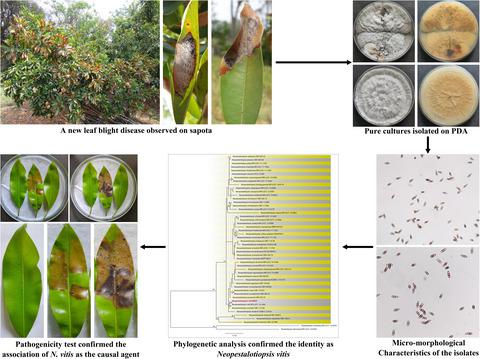当前位置:
X-MOL 学术
›
Lett. Appl. Microbiol.
›
论文详情
Our official English website, www.x-mol.net, welcomes your
feedback! (Note: you will need to create a separate account there.)
Morphological and molecular characterization of Neopestalotiopsis vitis associated with leaf blight disease of Manilkara zapota—a new record from India
Letters in Applied Microbiology ( IF 2.0 ) Pub Date : 2021-06-07 , DOI: 10.1111/lam.13521 B R Nuthan 1, 2 , B R Meghavarshinigowda 2, 3 , S S N Maharachchikumbura 4 , Shivannegowda Mahadevakumar 2, 3 , K M Marulasiddaswamy 2, 5 , C R Sunilkumar 2 , K N Amruthesh 3 , Sreedharamurthy Satish 1
Letters in Applied Microbiology ( IF 2.0 ) Pub Date : 2021-06-07 , DOI: 10.1111/lam.13521 B R Nuthan 1, 2 , B R Meghavarshinigowda 2, 3 , S S N Maharachchikumbura 4 , Shivannegowda Mahadevakumar 2, 3 , K M Marulasiddaswamy 2, 5 , C R Sunilkumar 2 , K N Amruthesh 3 , Sreedharamurthy Satish 1
Affiliation

|
Sapota is an important horticultural crop grown in India, and Karnataka is a major producer of sapota. A characteristic leaf blight disease was observed in Southern Karnataka during field surveys conducted in 2019 with an incidence of 13–22% in approximately 45 ha of sapota field. The leaf blight-associated pathogen was isolated on the potato dextrose agar medium. A total of 12 isolates obtained from each location were identified culturally and morphologically. Based on the morphological and cultural features, the pathogen was identified as Pestalotiopsis or Neopestalotiopsis, which was further confirmed by molecular identification using a representative isolate (MZ03). The ITS rDNA and β-tubulin genes were amplified and sequenced using ITS1/ITS4 and T1/T22 primer pairs respectively. nBLAST search analysis and concatenated (ITS-rDNA and TUB2 loci) phylogenetic analysis confirmed the pathogen identity as Neopestalotiopsis vitis. Pathogenicity tests conducted on detached leaves by inoculation with a conidial suspension of N. vitis produced typical blight symptoms after 4–5 days and progressed to cover the entire leaf lamina after 10–12 days. The pathogen’s identity was confirmed after re-isolation by cultural and morphological features. Although Pestalotiopsis clavispora and Pestalotiopsis versicolor causing diseases on sapota seedlings and trees have been reported, no reports are available for the occurrence of N. vitis to sapota from India. This is the first report of N. vitis associated with leaf blight disease of sapota from India.
中文翻译:

与Manilkara zapota 叶枯病相关的Neopestalotiopsis vitis 的形态和分子特征——印度的新记录
萨波塔是印度种植的重要园艺作物,卡纳塔克邦是萨波塔的主要生产地。在 2019 年进行的田间调查期间,在南卡纳塔克邦观察到一种特征性叶枯病,在大约 45 公顷的 sapota 田地中发病率为 13-22%。叶枯病相关病原体在马铃薯葡萄糖琼脂培养基上分离。从每个位置获得的总共 12 个分离株在文化和形态上被鉴定。根据形态和培养特征,病原体被鉴定为Pestalotiopsis或Neopestalotiopsis,通过使用代表性分离物 (MZ03) 的分子鉴定进一步证实了这一点。分别使用 ITS1/ITS4 和 T1/T22 引物对对 ITS rDNA 和 β-微管蛋白基因进行扩增和测序。nBLAST 搜索分析和串联(ITS-rDNA 和 TUB2 基因座)系统发育分析证实病原体身份为Neopestalotiopsis vitis。通过接种N分生孢子悬浮液对脱落的叶子进行致病性测试。葡萄球菌在 4-5 天后产生典型的枯萎病症状,并在 10-12 天后发展到覆盖整个叶片。病原体的身份在通过文化和形态特征重新分离后得到确认。虽然Pestalotiopsis clavispora和花斑长柄蠹病已见报道,但尚无报道N . vitis从印度到 sapota。这是首次报道N.葡萄来自印度sapota的叶枯病有关。
更新日期:2021-06-07
中文翻译:

与Manilkara zapota 叶枯病相关的Neopestalotiopsis vitis 的形态和分子特征——印度的新记录
萨波塔是印度种植的重要园艺作物,卡纳塔克邦是萨波塔的主要生产地。在 2019 年进行的田间调查期间,在南卡纳塔克邦观察到一种特征性叶枯病,在大约 45 公顷的 sapota 田地中发病率为 13-22%。叶枯病相关病原体在马铃薯葡萄糖琼脂培养基上分离。从每个位置获得的总共 12 个分离株在文化和形态上被鉴定。根据形态和培养特征,病原体被鉴定为Pestalotiopsis或Neopestalotiopsis,通过使用代表性分离物 (MZ03) 的分子鉴定进一步证实了这一点。分别使用 ITS1/ITS4 和 T1/T22 引物对对 ITS rDNA 和 β-微管蛋白基因进行扩增和测序。nBLAST 搜索分析和串联(ITS-rDNA 和 TUB2 基因座)系统发育分析证实病原体身份为Neopestalotiopsis vitis。通过接种N分生孢子悬浮液对脱落的叶子进行致病性测试。葡萄球菌在 4-5 天后产生典型的枯萎病症状,并在 10-12 天后发展到覆盖整个叶片。病原体的身份在通过文化和形态特征重新分离后得到确认。虽然Pestalotiopsis clavispora和花斑长柄蠹病已见报道,但尚无报道N . vitis从印度到 sapota。这是首次报道N.葡萄来自印度sapota的叶枯病有关。











































 京公网安备 11010802027423号
京公网安备 11010802027423号